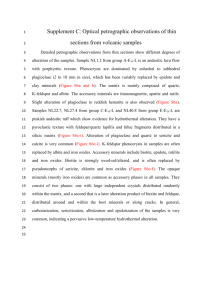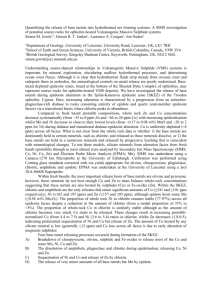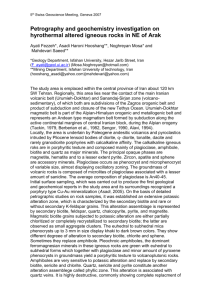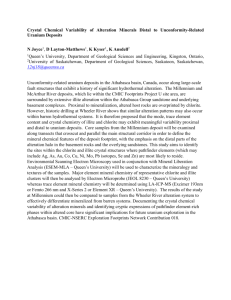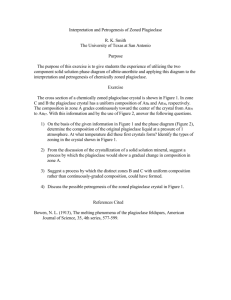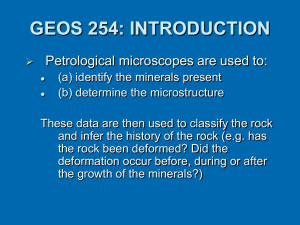Petrography and Mineralogy of Dolerites of Hachi Volcanics, Kirana
advertisement
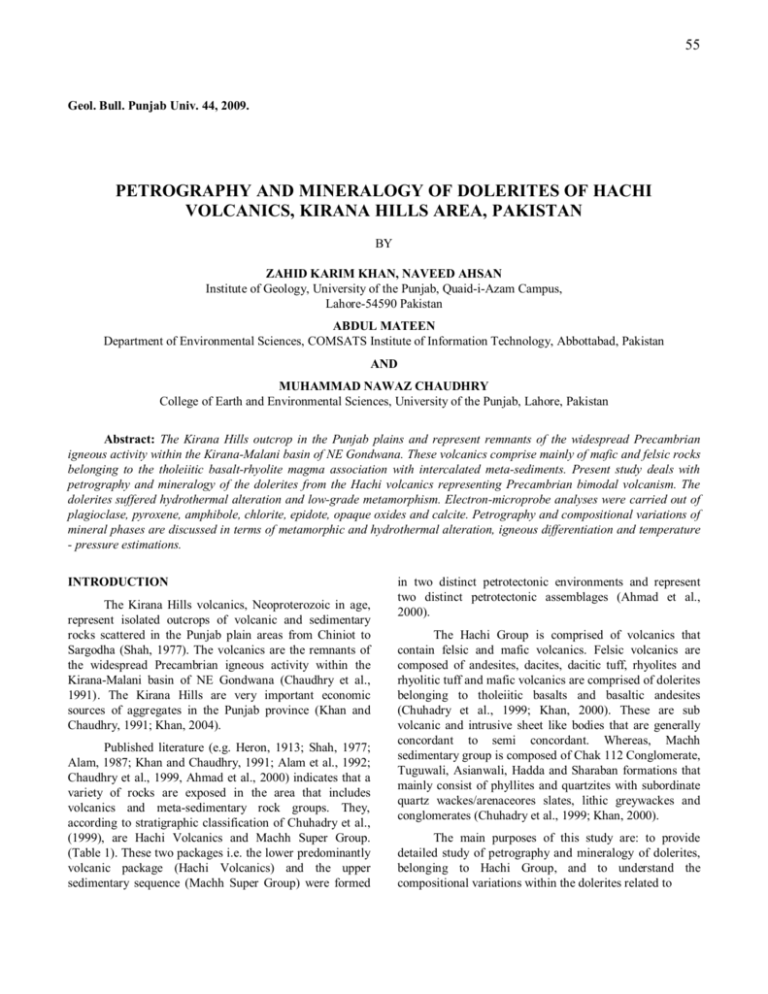
55 Geol. Bull. Punjab Univ. 44, 2009. PETROGRAPHY AND MINERALOGY OF DOLERITES OF HACHI VOLCANICS, KIRANA HILLS AREA, PAKISTAN BY ZAHID KARIM KHAN, NAVEED AHSAN Institute of Geology, University of the Punjab, Quaid-i-Azam Campus, Lahore-54590 Pakistan ABDUL MATEEN Department of Environmental Sciences, COMSATS Institute of Information Technology, Abbottabad, Pakistan AND MUHAMMAD NAWAZ CHAUDHRY College of Earth and Environmental Sciences, University of the Punjab, Lahore, Pakistan Abstract: The Kirana Hills outcrop in the Punjab plains and represent remnants of the widespread Precambrian igneous activity within the Kirana-Malani basin of NE Gondwana. These volcanics comprise mainly of mafic and felsic rocks belonging to the tholeiitic basalt-rhyolite magma association with intercalated meta-sediments. Present study deals with petrography and mineralogy of the dolerites from the Hachi volcanics representing Precambrian bimodal volcanism. The dolerites suffered hydrothermal alteration and low-grade metamorphism. Electron-microprobe analyses were carried out of plagioclase, pyroxene, amphibole, chlorite, epidote, opaque oxides and calcite. Petrography and compositional variations of mineral phases are discussed in terms of metamorphic and hydrothermal alteration, igneous differentiation and temperature - pressure estimations. INTRODUCTION The Kirana Hills volcanics, Neoproterozoic in age, represent isolated outcrops of volcanic and sedimentary rocks scattered in the Punjab plain areas from Chiniot to Sargodha (Shah, 1977). The volcanics are the remnants of the widespread Precambrian igneous activity within the Kirana-Malani basin of NE Gondwana (Chaudhry et al., 1991). The Kirana Hills are very important economic sources of aggregates in the Punjab province (Khan and Chaudhry, 1991; Khan, 2004). Published literature (e.g. Heron, 1913; Shah, 1977; Alam, 1987; Khan and Chaudhry, 1991; Alam et al., 1992; Chaudhry et al., 1999, Ahmad et al., 2000) indicates that a variety of rocks are exposed in the area that includes volcanics and meta-sedimentary rock groups. They, according to stratigraphic classification of Chuhadry et al., (1999), are Hachi Volcanics and Machh Super Group. (Table 1). These two packages i.e. the lower predominantly volcanic package (Hachi Volcanics) and the upper sedimentary sequence (Machh Super Group) were formed in two distinct petrotectonic environments and represent two distinct petrotectonic assemblages (Ahmad et al., 2000). The Hachi Group is comprised of volcanics that contain felsic and mafic volcanics. Felsic volcanics are composed of andesites, dacites, dacitic tuff, rhyolites and rhyolitic tuff and mafic volcanics are comprised of dolerites belonging to tholeiitic basalts and basaltic andesites (Chuhadry et al., 1999; Khan, 2000). These are sub volcanic and intrusive sheet like bodies that are generally concordant to semi concordant. Whereas, Machh sedimentary group is composed of Chak 112 Conglomerate, Tuguwali, Asianwali, Hadda and Sharaban formations that mainly consist of phyllites and quartzites with subordinate quartz wackes/arenaceores slates, lithic greywackes and conglomerates (Chuhadry et al., 1999; Khan, 2000). The main purposes of this study are: to provide detailed study of petrography and mineralogy of dolerites, belonging to Hachi Group, and to understand the compositional variations within the dolerites related to 56 Table 1 Stratigraphic Classification of Kirana area (Chaudhry et al., 1999) Top not preserved Group Formation Description Sharaban Formation Conglomerates with slate intercalations. Hadda Formation Calcareous quartzites Asianwala Formation Mainly quartzites with sub ordinate quartz wackes / arenaceous slates, gritty quartzites and slates, often showing cross bedding and ripple marks. Tuguwali Formation Slates, fine grained quartz wackes / arenaceous slates Chak 112 Conglomerates Polymict conglomerate with clasts of dolerite and acid volcanics. Volcanogenic slates Often interbedded with rhyolite / rhyolitic tuff and dolerite Volcanics Dolerites, andesites, dacites, dacitic tuff, rhyolites and rhyolitic tuff. Machh Super Group Hachi Volcanics Base not exposed Table 2 Modal mineralogy of dolerites from Bulland Hill and Sheikh Hill quarries of Kirana Bulland Hill Sheikh Hill Mineralogy (%age) C-2 C-9 C-12 C-13 C-15 C-36 C-52 C-72 BH101 C-69 Quartz 8.0 9.0 8.0 5.0 3.0 3.0 0.0 2.0 1.0 7.3 Plagioclase 25.0 27.0 25.0 26.0 23.0 26.5 37.0 21.5 31.5 32.7 Pyroxene 3.0 0.0 3.0 8.5 10.0 0.0 0.0 5.0 1.5 3.5 Amphibole 25.5 17.0 25.5 19.5 13.0 8.3 16.0 29.5 15.0 18.0 Sphene 4.5 3.0 4.5 2.0 2.5 1.0 0.0 3.0 3.0 5.0 Epidote 0.0 2.0 0.0 2.5 1.5 2.5 1.0 4.0 3.0 2.0 Chlorite 23.5 22.0 23.5 17.0 12.0 23.2 23.0 26.0 23.5 5.0 Calcite 6.5 13.0 6.5 12.0 28.0 29.0 17.0 3.5 13.8 19.4 Ilmenite/ leucoxene 1.0 3.0 1.0 3.5 3.0 5.0 4.0 3.0 5.0 3.1 Hydromica 3.0 4.0 3.0 4.0 4.0 1.5 2.0 2.5 2.7 4.0 57 magmatic differentiation and subsequent metamorphic and hydrothermal alterations. Sampling of dolerites The dolerites of the Kirana volcanics investigated in this study include all the mafic rock suites in the compositional range of SiO 2 upto 55 wt%. The rock suites categorized as dolerites consist of tholeiitic basalts, basaltlic andesites and microgabbros. The dolerites are present in quarries situated around the Bulland Hill, 126, Sheikh Hill, 116, Chak 123 and Kila Minor, 128. In all, 10 samples were collected from Bulland Hill and Sheikh Hill (Table 2) to determine modal mineralogy and carry out microprobe analyses. In addition to this, mineralogy of two samples (C12 and C-36) was checked and analyzed by X-ray diffraction. X-RAY DIFFRACTION IDENTIFICATION Whole rock representative samples of dolerites were crushed to a < 10µm powder to obtain x-ray diffraction patterns for the identification of primary igneous minerals and their alteration products. Composition of the mineral grains was subsequently determined by microprobe analysis. Petrographic observations have clearly indicated variable alteration of dolerites. X-ray diffraction patterns of typical representative dolerite samples C-12 and C-36 are displayed in Fig. 1. The secondary alteration assemblage in dolerites is identified as chlorite, epidote, feldspar (albite) and possible clay minerals. The altered dolerites lack olivine and pyroxene. The mafic rock suites have suffered alteration to considerable degree due to chloritization, epidotization, calcitization and sericitization. PETROGRAPHY Modal mineralogy data for dolerite samples studied are given in Table 2. The dolerites of the Kirana volcanics investigated include all mafic rock suites, consisting of tholeiitic basalts, basaltic andesites and microgabbros. The dolerites invariably show alteration, though unaltered dolerites are recognized at places. The dolerites can be grouped into two varieties. Unaltered dolerites are generally hollocrystalline, rarely porphyritic and lack directional texture. The altered dolerites are fine to medium grained and lack olivine and pyroxene. The rock suites have suffered alteration due to extensive chloritization, calcitization, sericitization and epidotization. The altered dolerites are comprised of chlorite, amphibole, plagioclase, quartz, sericite, calcite, epidote, ilminite/leucoxene, sphene and hematite (Fig. 2). The dolerites are generally fine to medium grained and dark green to light green in color. They have been extensively altered due to hydrothermal activity. The volcanic rocks of the Kirana hills have been metamorphosed to low-temperature mineral assemblage that includes chlorite, epidote, albite, sericite and carbonates. However, clinopyroxene, amphibole and opaque (ilmenite) grains are the primary magmatic phases. Plagioclase is replaced by epidotes, carbonate and sericite, while pyroxene and olivine are replaced by chlorite and actinolitic hornblende. The dolerites have suffered low grade metamorphism and autometasomatism. Some dolerites contain relics of clinopyroxene and calcic plagioclase phenocrysts (Alim et al., 2000). The altered dolerites are hollocrystalline and composed of chlorite ± epidote ± amphibole + albite + quartz + calcite ± ilmenite/leucoxene. The dolerite bodies are, at places, cut by quartz (Fig. 3) and carbonate veins. They may exhibit flow structures with parallel to sub-parallel orientation of feldspar laths and microphenocrysts. Texture ranges from intersertal, intergranular, subophiotic to ophitic in dolerites. Plagioclase is variably sassuritised. Plagioclase twinning and grain-boundaries have been obliterated. Interstitial material, consisting mainly of chlorite is common within the dolerites and was probably derived from the pyroxene and amphibole. Primary oxide grains occupy the interstices between feldspar laths. Interstitial chlorite is widespread and appears to have replaced primary ferromagnesian material. According to Davies and Crawford (1971), the dolerites of the Kirana Hills are autometasomatic types that have produced late stage concentrations of hydrothermal carbonate-rich fluids. The late hydrothermal activity caused breakdown and albitization of plagioclase feldspar and breakdown of ferromagnesian minerals. The migration of hydrothermal fluids into the nieghbouring pre-existing rhyolites was responsible for alteration and accompanied by deposition of quartz, ankeritic carbonates, calcite and hematite in the available fractures, cavities and pore-spaces. A few thin doleritic instrusions contain plagioclase with rather altered pyroxene and brown olivine relicts. Pyroxenes in less altered dolerites are generally subhedral to eumorphic and may occur as discrete crystals as well as aggregates. The phenocrysts often enclose subophitically, laths of calcic-plagioclase of andesine composition. Cracks and fractures of pyroxene may be filled by secondary calcite. Pyroxene is generally augite and may marginally alter to hornblende. However, pyroxene and olivine are rare minerals and may occur only as relics in dolerites. Hornblende occurs as euhedral to subhedral phenocrysts as well as smaller crystals in the groundmass. Hornblende may also ophitically enclose laths of calcicplagioclase. Rarely acicular to columnar aggregates of 58 actinolite may also occur. Hornblende may show marginal alteration to chlorite. Plagioclase is subhedral to eumorphic and occurs as well formed prismatic crystals. Plagioclase occurs both as pheocrysts as well as smaller crystals in the groundmass. The crystals of plagioclase are well twinned on albite law. Combined carlsbad-albite twins are rare. The plagioclase is variably and erratically sassuratised/calcitised. The products of this alteration are epidote, sericite and calcite. Sericite, epidote and calcite are the major components of this alteration. Plagioclase crystals and laths are sometimes traversed by epidote, calcite and chlorite veinlets. These vein lets are in fact late stage and post consolidation fracture fillings. Chlorite varies widely in this unit. It may occur as pseudomorphs after amphibole or may develop as aggregates of small flaky crystals. It is strongly pleochroic from neutral green to bright green and shows a variety of interference colours, most common being tobacco green and bluish green. It appears to be Fe-Mg-rich chlorite. It is generally very fine to fine grained and occurs as flake and fibre like aggregate. Epidote is usually anhedral and occurs as an alteration product of plagioclase and amphibole. It may occur as smaller grains, or granular masses. It varies from colourless to pale. The interference colours show that both zoisite and clinozoisite are present, since both normal and anomalous interference colors are observed. Size of epidote grains ranges from 0.01 mm to 0.52 mm in general. Calcite is a secondary mineral and occurs as anhedral to subhedral crystals of widely variable size. Its amount varies widely and it may, therefore, occur as an accessory to essential mineral. It either forms extremely fine-grained microcrystalline aggregates or occurs as clear and well-formed discrete crystals and their aggregates. It may also occur as fracture filling mineral within plagioclase. Ilmenite and leucoxene are anhedral occurring as aggregates as well as discrete crystals. Alteration of ilmenite to leucoxene is very prominent. MINERALOGY OF DOLERITES The mineralogy of dolerites of the Kirana Hills has been investigated for seeking information on the nature of mineral phases of primary igneous crystallization and subsequent alteration products developed by hydrothermal activity. The mineral compositions were determined on two dolerite samples, relatively unaltered dolerite (Sample No. 12) and altered dolerite (Sample No. 36). Microprobe analyses of minerals were carried out on electron microprobe (Jeol Super probe JXA-8600, Leicestere University, UK). The mineral phases have been recalculated on a stoichiometric basis of oxygen and cations following the recommendations of the International Association Subcommittee on the nomenclature of minerals. The purpose of microprobe analysis has been to understand the nature of primary magmatic mineral and to identify the alteration products. The compositional variations in the mineral phases are interpreted in terms of magmatic differentiation and extent of alteration of dolerites. Plagioclase Mineralogical data of plagioclase in the dolerite is quite unusual and fall in the field of sodium-rich phases Albite-oligoclase rather than Ca-rich member of plagioclase generally expected in the igneous mafic suites. The dolerite samples analyzed (Sample No. 36) from the quarries are altered dolerites. Compositional variations in terms of AnAb-Or components of the plagioclase analysed are shown in Figure 4 a. Plagioclase ranges in composition from An 24 to An 1.5 in sample 12, while plagioclase in the highly altered dolerite sample 83 is almost albitic (An 0.9 Ab98.7 Or 0.4 Ab96.6 Or 0.9 , Figure. 4a). The observed plagioclase compositions in the altered dolerites may be interpreted in terms of complete alteration of primary dolerites (basalts and basaltic andesites). Plagioclase exhibits fine laminar intergrowth of two phases of Ca-rich and Na-rich composition. The Ca-rich plagioclase is most susceptible to hydrothermal alteration to more sodic varieties due to late stage action of hydrothermal solutions (Deer et. al., 1992). Late stage magmatic and metasomatic process may also shift the composition of Ca-rich plagioclase towards Narich albite phase. Accordingly dolerites (normal basalts and basaltic andesites) must have suffered alteration and albitized to spilitic minerology. Thus albite is the stable phase in the altered dolerites. Plagioclase in bleached zone differs markedly by having a composition close to pure albite. Figure 4 b displays a plot of mole % An versus mole % albite which clearly shows that the bleached plagioclase tends to be albitic. Evidently the alteration causing bleaching is associated with the removal of Ca, which must have crystallized as carbonate, as indicated by the frequent occurrence of carbonate-filled microfractures in these zones. Pyroxene The pyroxene grains from dolerite samples 12 and 36 were analyzed. The compositions have been recalculated on the basis of 4 cations and 6 oxygen atoms. Fe3+ is estimated using stoichiometric criteria according to the method of Droop (1987). Pyroxene compositions are 59 plotted in terms of Q-J diagram for preliminary fall in the domain of Quad (Fig. 5 a.) The pyroxene compositions are also plotted on the recommended amplified Quad classification diagram (Figure 5 b) after Rock (1990) in terms of Ca-Fe-Mg. The pyroxene compositions fall within the Fe-rich augite to subcalcic augite fields. Pigeonitic pyroxene is absent. Pyroxenes display narrow compositional variation as shown in Q-J and quadrilateral diagrams which summarize the compositional ranges of pyroxenes for the dolerites (Figure 5 a, b). The composition falls in the range of Ferich augite (Wo25.8 En 26.2 Fs 40.8 ). Their Fe/(Fe+Mg) ratios lie between 0.17 to 0.5. The alumina varies from 1.1. wt.% to 5.4 wt.%. TiO 2 contents are variably low in the range from 0.03 to 0.9 wt.% in sample 12, while the sample 83 has extremely low TiO 2 content falling in 0.0 to 0.23 wt.%. Kushiro (1960) proposed that during magmatic crystallization, the proportion of Si increases in the pyroxene structure whereas that of Al in tetrahedral site decreases. ivAl > vial is somewhat typical for pyroxene formed at high temperature. These two characteristics combined suggest that the pyroxene in the Kirana dolerites probably crystallized at relatively moderate temperature (Figure 5 c). Pyroxene appears crystallizing after olivine and plagioclase in dolerites (basalts and basaltic andesites), after or simultaneously with plagioclase in more evolved rocks, but always before opaque Fe-Ti oxide minerals. Amphibole Amphibole compositions have Si atoms per formula unit (apfu) ranging from 7.25 to 7.58 apfu and can be classified in the IMA nomenclature (Leake et. al., 1997) as actinolite to magnesio-hornblende (calcic amphibole). Optical mineralogy also confirms the presence of actinolite patches. In the cationic Mg/(Mg+ Fe2+) versus (Si) and Ca B versus (Na+K) A diagrams (Figure 6 a, b), the amphiboles from dolerite samples show a trend from actinolite to endenite. Two distinct variations in chemical compositions of amphibole phases in dolerite may be related to magnesiohornblende (Sample No. 12) and ferro – actinolite (sample 36) representing basalt and basaltic andesite suites respectively. Hornblende is characteristic mineral of intermediate igneous rocks and may also occur as primary crystallization of basic rocks such as basaltic andesites (Deer et al. 1992). Nevertheless, actinolitic hornblende association is generally developed in low-grade greenschist facies metamorphism of mafic rocks. The occurrence of magnesio-hornblende and ferro-actinolite in the Kirana mafic suite supports their secondary origin. The amphiboles may have been derived from primary pyroxene through magmatic-hydrothermal activity. Also hornblende and some Fe-Ti oxides may be subsolidus products from breakdown of pyroxene in dolerites. Compositional limit for igneous amphiboles is shown in Figure 7 with respect to (Ca+Na+K) and Si formula unit (Leake, 1971; Wones and Gilbert, 1982). The (Ca+Na+K) versus Si plot allows chemical discrimination between igneous and metamorphic amphiboles (Leake, 1971). The amphiboles from dolerites plot in the igneous as well as metamorphic field of the diagram. This behaviour is interpreted as an indication that amphiboles are igneous actinolite to magnesio-hronblende however their chemistry has been partially affected by reaction with the hydrothermal fluids causing compositional modification. Chlorite Incipient alteration of igneous mica and amphibole to chlorite is widespread, thus making chlorite minerals among the most dominant product of alteration in dolerites. The number of cations in the unit cell were calculated on the basis of 28 oxygens [based on chlorite formula Y 12 Z 8 O 20 (OH, F) 16 ]: Y and Z represent octahedral and tetrahedral cations respectively. Compositional variations of chlorite are plotted in terms of binary relationships of Fe/(Fe + Mg) ratios versus cationic Si and Al in T-site as shown in Figure 8 and 9. Most of the microprobe data points fall within the pycnochlorite field. The analyzed chlorite shows a restricted range of composition from ripidolite-pynochlorite to diabantie (according to the classification of Foster, 1962). As shown in Figure 9, chlorite of the Kirana dolerites defines comparable compositional range of Mg-Fe chlorites (Deer et. al., 1992) of the stable metamorphic chloride field (Bailey, 1987). Ca, Na and K contents are negligibly low which are suggested to occur as impurities in chlorite (Albee, 1962). These elements are occasionally absorbed or occur as interlayer cations in the chlorites (Czamanske et. al., 1981). Chlorites have been extensively studied in the igneous environment (Eggleton and Banfield, 1985; AbdelFattah and Abdel-Rahman, 1995) in meta volcanics (Al Dahan et. al., 1988; Bettison and Schiffman, 1988) and hydrothermal ore deposits (Kranidiotis and Maclean 1987; Shikazono and Kawahata, 1987; Nutt, 1989). The relationship of Mg and Fe contents provides best discriminant between the chlorites phases occurring in igneous suites (Figure 9.) The chlorite from the dolerites of Kirana volcanics exhibit compositional range which is comparable to the chlorites in the calc-alkaline rocks. Fe/(Fe+Mg) ratios vary in the range of 0.398 to 0.501. The pycnochlorites indicate a trend toward increasing Fe that appear to correspond to the degree of alteration. Intense chloritization in felsic igneous rocks represent the first 60 alteration stage after quartz dissolution. The chlorite of this generation consists of psedudomorphs after biotite. The chlorites generations are crystallized at temperatures 300200oC at a constant pressure of 1 Kbar (Walsche, 1986). Microprobe data indicate a restricted range of chemical composition falling around Mg-Fe chlorite (comparison with analyses reported by Deer et al., (1992). Chlorite is a widespread secondary phase of dolerites particularly with a composition of altered basalt and basaltic andesites in Kirana. Extensive development of chlorite phase in the mafic suites is due to hydrothermal alteration of primary crystallizing phase of ferromagnesian minerals. Chlorite may be interpreted to have been formed by hydrothermal replacement of pyroxene and amphibole. The compositional range can be related to primary Mg-Fe silicate phases of pyroxene and amphibole crystallizing in the mafic suites of Kirana hills. Epidote Microprobe data indicate that all the epidotes are Ferich. The atomic% Fe3+ (Fe3+ +Al) ratio expressed, as Pistaciite contents (Ps = 100×Fe3+ /(Fe3+ + Al)) varies in the range of Ps 16.4 to Ps 31.6 for the magmatic epidote in the Kirana dolerites. The Ps values are mostly comparable with a variation equivalent to that of epidote phenocryst in the calc-alkalic dykes of the Front Range of Colorado (Dawes and Evans, 1991) that is one of the strongest example of magmatic epidote. Similar compositional range is found in magmatic epidotes of granodioritic plutons (Rogers, 1988; Owen, 1991; Farrow and Barr, 1992). MnO contents range from 0.0 to 0.24 wt.% while MgO contents are very low upto 0.21 wt.% while TiO 2 , Na 2 O and K 2 O contents are negligible. Fe-rich epidotes generally indicate low-grade greenschist facies metamorphic conditions (Cooper, 1972). Microprobe data show that the epidote in dolerite is slightly rich in Fe2+ and can be distinguished from amphibole by its characteristic pleochroism. Presence of epidote indicates that the dolerites have suffered low-grade metamorphism. The contents of epidote have been derived from the plagioclase. Amphibole + epidote + chlorite + albite mineral assemblage in the dolerite aggregate of Kirana Hills area provides strong evidence of alteration and low-grade green schist facies metamorphism. Fe-Ti Oxide Titano-magnetite and ilmenite are opaque mineral phases ubiquitously present in dolerite samples. The cationic compositions have been calculated on the basis of 3 oxygen and 2 cations for titano-magnetite and ilmenite respectively. A typical feature of the titano-magnetite is that it has very low contents of MnO compared to that of ilmenite. From the inspection of the data, the Fe-Ti oxides in the dolerites appear to have been extensively reequilibrated. Magnetite and ilmenite pairs in igneous rocks are of particular importance because of their potential to yield information about magmatic temperatures. Unfortunately the analyzed Fe-Ti oxides are exsolved. The Buddington and Lindsley (1964) magnetite-ilemenite geothermometer/oxygen barometer is of very limited use for the compositions. The compositions merely indicate that the oxides requilibrated during the cooling to temperature of 530oC. The more fractionated dolerites (Sample 36) contain magnetite with high TiO 2 content in the range from 10 to 18.3 wt.%. As a result these oxides can be called titanomagnetities. The range of TiO 2 (and equivalent Ulvospinel Fe 2 TiO 4 ) in magnetite is well within the range of the basaltic volcanic rocks worldwide (Buddington and Lindsley, 1964). The titano-magnetite of volcanic rocks coexists with ilmenites that have substantially higher values of Fe 2 O 3 . This is due to greater degree of oxidation of the volcanic rocks as a result of subsolidus oxidation by solutions at relatively low temperatures. The main opaque oxide phase is titano-magnetite. Although there exists a complete solid section screen between ilmenite and hematite, the compositions of Ti-Fe oxide phase do not show typical igneous ilmenitemagnetite phase relationship with ulvospinel component. The compositions of Ti-Fe oxides phase indicate that it contains appreciable contents of SiO 2 and CaO. The alteration of primary igneous Ti-Fe oxide phase may have taken palce at various stages of post-magmatic hydrothermal activity in the Kirana volcanics. The alteration products may be mixtures of amorphous Fe-Ti oxides and leucoxene (Deer et al. 1992). Titanite (Sphene) The cationic compositions have been calculated on the basis of 3 cations and 5 oxygens. Analysed sphenes are slightly low in titanium and contain appreciable contents of aluminium and iron. The compositions may be compared with gothite variety of sphene (Deer et. al., 1992). Sphene is an essential accessory phase in dolerites and exhibits weak pleochroism in yellowish to brown colours. Calcite Calcite is relatively free from Mg and Fe contents (low in MgO = 0.26 wt% and FeO = 0.67 wt%). The composition is fairly close to pure calcite. The presence of calcite phase in dolerite is due to hydrothermal activity in the Kirana volcanics. Crystallization of calcite in dolerites is secondary and represents late stage hydrothermal precipitation. 61 62 63 64 65 TEMPERATURE AND PRESSURE ESTIMATION The estimates of temperature for Kirana dolerites are made using pyroxene thermometry (Lindsley, 1983) Figure 5 c displays the plot of pyroxene data on graphical thermometer, calibrated for 1 atmosphere pressure. It indicates a complex cooling history through a wide range of temperatures, for the Kirana dolerites. A temperature range of 1100oC to 800oC is established from the graph of Lindsley (1983). Similarly temperature estimate spectrum have been established for the tholeiitic dolerites in alkaline provinces elsewhere (Hall and Hughes, 1986). The total Al content of amphibole can be used to estimate the pressure of solidification of this phase in dolerites. Successive empirical and experimental calibrations (Hammarstom and Zen, 1986; Johnson and Rutherford, 1989; Schmidt, 1992) improved this barometer. According to Johnson and Rutherford (1989) calibration was obtained by performing experiments on natural samples under CO 2 + H2 O volatile pressures. Presence of magmatic episode implies a low CO 2 activity during crystallization of the post magma (Ghent et al., 1991; Helmy, 2004). Therefore, Schmidt (1992) calibration was applied. The dolerite samples studied vary in Al from 0.494 to 1.006 apfu. If the entire Al in this phase is ascribed to pressure and Schmidt equation is used, pressures of solidification in the 5-7 K bar range are obtained from amphibole study. REFERENCES Abdel-Fattah and Abdel-Rahman, 1995. Chlorites in a Spectrum of Igneous Rocks: Mineral Chemistry and Paragenesis, Mineralogical Magazine 59, pp. 129-141. Ahmad, S. A., Mateen, A., khan, Z.K. and Chaudhry, M.N., 2000. Geology and geochemistry of Neoproterozoic Kirana Volcanics, Sargodha district, Punjab, Pakistan, Geol. Bull. Punjab Univ., 35, 59-71. Alam, G.S. 1987. Geology of Kirana Hills District Sargodha, Punjab 1, Pakistan, G.S.P. Quetta, Pakistan. 1-37. Alam, G.S., Jaleel, A. and Ahmad, R. 1992. Geology of the Kirana area, District Sargodha Punjab, Pakistan. Acta Mineralogica Pakistanica, 6, 93-100. Albee, A.L., 1962. Relationship between the mineral association, chemical composition and physical properties of the chlorite series. American Mineralogist, 47, pp. 851-870. Al-Dahan, A.A.Ounchanum, P., and Morad, S.. 1988. Chemistry of micas and chlorite in Proterozoic acid metavolcanics and associated rocks from the Hästefält area, Norberg ore district, central Sweden. Contributions to Mineralogy and Petrology, 13, pp. 457-492. Bailey, D. K., 1987. Mantle metasomatism: perspective and prospect. In: Fitton, J. G. and Upton, B. G. J. (eds.) Alkaline Igneous Rocks. Blackwell, London, pp.1-33. Bettison, L.A. and Schiffman, P., 1988. Compositional and structural variations of phyllosilicates from the Point Sal ophiolite, California. American Mineralogist, 73, 62-76. Brown, G.C., Thorpe, R.S. and Webb, P.C.,1984, The geochemical characteristics of granitoids in contrasting arcs and comments on magma sources.Jour.Geol.Soc.Lond.,141,411-426 Buddington A.F. and Lindsley D.H., 1964. Iron–titanium oxide minerals and synthetic equivalents. Journal of Petrology, 5, 310–357. Chaudhry, M.N., Ahmad, S.A. and Mateen, A., 1999. Somepostulates on the tectanomagmatism, tectanostratigraphy and economic potential of Kirana-malani-Basin, Indo-Pakistan, Pakistan Journal of Hydrocarbon Research, 11, 52-68. Cooper, A. F., 1972. Progressive metamorphism of metabasic rocks from the Haast Schist Group of southern New Zealand. Journal of Petrology, 13, pp. 457-492. Czamanske, G.K., Ishihara, S. and Atkin, S.A., 1981. Chemistry of rock-forming minerals of the Cretaceous-Paleocene Batholith in southwestern Japan and implications for magma genesis. Journal of Geophysical Research, 86, 1043110469. Davies, R.G. and Crawford. A.R., 1971. Petrography and age of the rocks of Buland hills, Sargodha Districts West Pakistan, Geological Magazine, 108, pp. 235-246. 66 Dawes, R.L. and Evans, B.W., 1991. Mineralogy and geothermometry of magmatic epidote bearing dikes, Front Range, Colorado. Geological Society of America Bulletin, 103, 1017–1031. Deer, W. A., Howie, R. A., and Zussman, J., 1992. An Introduction to the Rock Forming Minerals, 2nd ed., Longman, London, 696pp. Droop, G. T. R., 1987. A general equation for estimating Fe3+ concentrations in ferromagnesian silicates and oxides from microprobe analyses using stoichiometric criteria. Mineralogical Magazine, 51, 431-435. Eggleton, R.A. and Banfield, J.F., 1985. The alteration of granitic biotite to chlorite. American Mineralogist, 70, 902–910. Farrow, C. E. G. and Barr, S. M. 1992. Petrology of high-alumina hornblende- and magmatic epidote-bearing plutons, southeastern Cape Breton Highlands, Nova Scotia. Canadian Mineralogist, 30, 377–392. Foster, M.D., 1962. Interpretation and a classification of the chlorite. US Geological Survey professional paper,414A, pp. 133. Ghent, E.D., Nicholls, J., Siminy, P.S., Sevigny, H.H. and Stout, M.Z., 1991. Hornblende geobarometry of the Nelson Batholith, Southeastern British Columbia: tectonic implications. Canadian Journal of Earth Science, 28, 1982–1991. Giret, A., Bonin B. and Léger J.M., 1980. Amphibole compositional trends in oversaturated and undersaturated alkaline plutonic ring complexes. Canadian Mineralogist, 18, 481–495. Hall, R. P. and Hughes, D. J., 1986. Complex sequential pyroxene growth in tholeiitic hypabyssal rocks from southern West Greenland. Mineralogical Magazine, 50, 491-502. Hammarstrom, J.M. and Zen, E. 1986. Aluminium in hornblende: an empirical igneous geobarometer. American Mineralogist, 71, 1297-1313. Hayes, P.T., 1970. Mesozoic stratigraphy of the Mule and Huachuca Mountains, Arizona: U.S. Geological Survey Professional Paper, 658-A, 27 p. Helmy, H.M., Ahmed, A.F., Mahallawi, M.M. El. and Ali, S.M. 2004. Pressure, temperature and oxygen fugacity conditions of calc-alkaline granitoids, Eastern Desert of Egypt, and tectonic implications. Journal of African Earth Sciences, 38, 255–268. Heron, A.M., 1913. The Kirana and other hills in the Jeeb and Rachna Doabs, Memoirs, G.S.I, Records, 43. Pt. 3, 229-236. Johnson, M. C., and Rutherford, M. J., 1989, Experimental calibration of the aluminum-in-hornblende geobarometer with application to Long Valley caldera (California) volcanic rocks: Geology, 17, p. 837–841. Khan, Z.K. 2004. Classification of base and sub-base of road aggregates in Kirana area, districts Jhang and Sargodha, Punjab. Workshop on Geological Materials/Aggregates of Pakistan, June 10, 2004, Islamabad. National Geological Society of Pakistan & Pakistan Museum of Natural History (Pakistan Science Foundation). Khan, Z.K. 2000. Study of the geology of Kirana Group, Central Punjab and evaluation of its utilization and economic potential as aggregate. Ph. D. thesis, University of the Punjab, Lahore, 1-240 Khan, Z.K. and Chaudhry, M.N., 1991. Engineering Geological and Petrographic Evaluation of Metadolerites of Buland Hill and Chak 123 Quarries of Kirana Hills, District, Sargodha, Pakistan. Kashmir Journal of Geology, 8-9, 181-184. Khan, Z.K., 2004. Classification of base and sub-base of road aggregates in Kirana area, districts Jhang and Sargodha, Punjab. Workshop on Geological Materials/Aggregates of Pakistan, June 10, 2004, Islamabad. National Geological Society of Pakistan & Pakistan Museum of Natural History (Pakistan Science Foundation). Kranidiotis, P. and MacLean, W.H., 1987. Systematics of chlorite alteration at the Phelps Dodge massive sulfide deposit, Matagami, Quebec. Economic Geology, 82, 1898-1911. Kushiro, I., 1960. Si-Al relations in clinopyroxenes from igneous rocks: American Journal of Science, 258, 548–554. Leake, B. E., Woolley, A.R., Arps, C. E. S., Birch, W. D., Gilbert, M. C., Grice, J. D., Hawthorne, F. C., Kato, A., Kisch, H. J., Krivovichev, V. G., Linthout, K., Laird, J., Mandarino, J., Maresch, W. V., Nickel, E. H., Rock, N. M. S., Schumacher, J. C., Smith, D. C., Stephenson, N. C. N., Ungaretti, L., Whittaker, E. J. W. and Youzhi, G. 1997. 67 Nomenclature of amphiboles: Report of the subcommittee on amphiboles of the international Mineralogical Association Commission on new minerals and mineral names. Mineralogical Magazine, 82, 1019-1037. Leake, B.E., 1971. On aluminous and edenitic hornblendes. Minerological magazine 38, 389-405. Lindslay, D. H., 1983. Pyroxene geothermometry. American Mineralogist, 68, 477-493. Nutt, C.J. 1989. Chloritization and Associated Alteration at the Jabiluka Unconformity-Type Uranium Deposit, NorthernTerritory, Australia. Canadian Mineralogist, 27, 41-58. Owen, J.V., 1991. Significance of epidote in orbicular diorite from the Grenville Front Zone, eastern Labrador. Mineralogical Magazine, 55, 173–181. Rock, N. M. S., 1990. The International Mineralogical Association (IMA/CNMMN) pyroxene nomenclature scheme: computerization and its consequences. Mineralogy and Petrology, 43, 99-119. Rogers, H. D. 1988. Field relations, petrography, and geochemistry of granitoid plutons in the Shelburne area, southern Nova Scotia; Geological Survey of Canada, Open File 1835. Schmidt, M. A., 1992. Amphibole composition in tonalite as a function of pressure: an experimental calibration of the Al-inhornblende barometer. Contributions to Mineralogy and Petrology, 110, 304-310. Shah, S.M.I., 1977, Stratigraphy of Pakistan: Geol. Surv. Pakistan, Quetta, Mem. No. 12,1-138. Shikazono, N. and Kawahata, H. 1987. Compositional differences in chlorite from hydrothermally altered rocks and hydrothermal ore deposits. Canadian Mineralogist, 25, 465-474. Walshe, J.L., 1986. A six-component chlorite solid solution model and the condition of chlorite formation in hydrothermal and geothermal systems. Economic Geology, 81, 681-703. Wones, D. and Gilbert, M. C. 1982. Amphiboles in the igneous environment. In: Veblen, D. R. and Ribbe, P. H. (eds) Amphiboles: Petrology and Phase Relations. Mineralogical Society of America, Reviews in Mineralogy 9B, 355–389.
